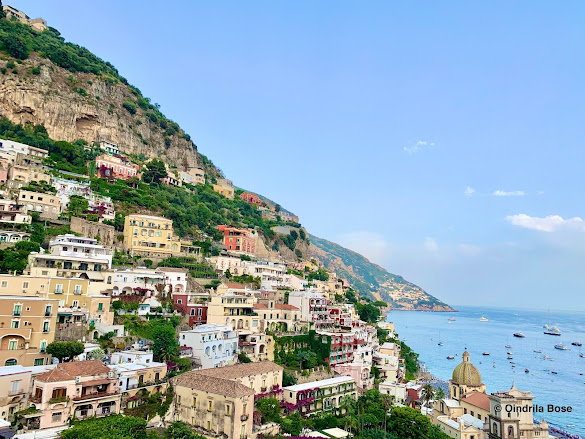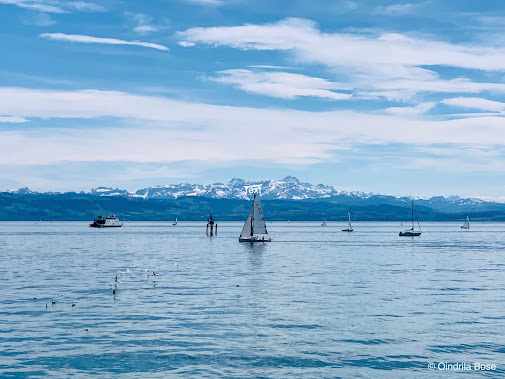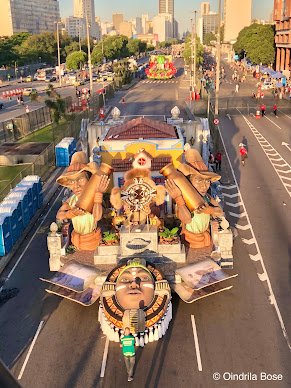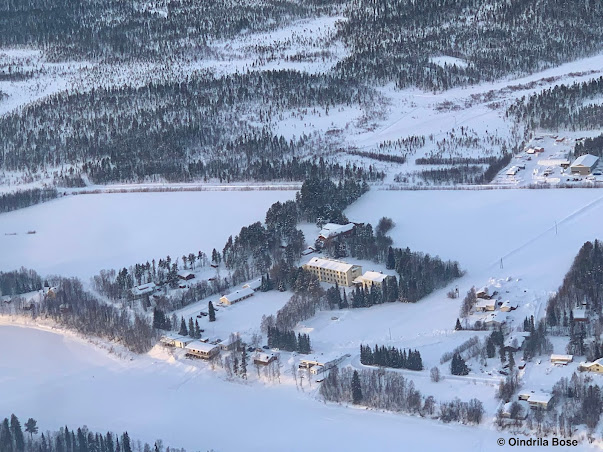Are you planning for a beach vacation but cannot decide which location to choose? How about visiting one of the most photographed coastal towns in Europe and capturing the best pictures for your travel album! No prizes for guessing that I am talking about the romantic town of Positano in southern Italy. In this post, I will share the highlights of our summer getaway to Positano and Naples in southern Italy with some important information to help you plan your trip.
Destination 1: Positano
Positano is known for its picture-perfect view of multi-colored houses perched on steep cliffs along deep blue waters. The Amalfi coast (specially Positano) is a rare combination of scenic coastlines, posh beaches and delicious food which make it a highly popular tourist destination in Europe.
 |
Mesmerizing view of Positano
|
 |
| Streets of Positano |
Scratch the map:
Positano is located on the Amalfi Coast overlooking the Tyrrhenian Sea in the Campania region of Italy. The mountain range in this area is called Lattari mountains. Positano is around 57 km from Naples and 270 km from Rome.
- Nearest airport: Naples International airport
- How to reach Positano: The easiest way to reach Positano from Naples airport is by hiring a private taxi. The distance from Naples airport can be covered in 1-1.5 hours via car (approximate price: €70-€80). A cheaper option is to take public transport (bus, train or ferry) from Naples to Positano. Keep in mind that if you take the ferry you will need to climb up maybe a hundred stairs with your luggage to reach the main road.
 |
| Emerald Grotto |
Additional tour options:
- Day trip to Capri island: If you have additional time, consider hiring a day long boat trip to the beautiful island of Capri for 7-8 hours. Group tours to Capri are provided by many boat tour operators who take you to the island with sightseeing on the way and give you 3-4 hours of free time to explore Capri.
- Path of Gods: If you like hiking, then definitely try the Path of Gods hike to be able to appreciate the true beauty of the Amalfi coast and the sea. The best route is to start from Bomerano and end in Nocelle which is about 7 kms long. This route offers a slightly downhill hike and it requires around 2-2.5 hours to complete the hike. However, you will first need to take a bus from Positano to get to Bomerano which takes about 90 minutes.
Personal Recommendations!
- Restaurant hopping: Positano is the ideal location to chill and enjoy some good seafood and wine. By the way, remember to make reservations at least 2-3 days ahead during the peak season otherwise you might miss out on the fabulous dining experience.
- La Tagliata: Dinner at La Tagliata is a must experience where you can try authentic home-cooked Italian cuisine (including handmade pasta). They serve a pre-fixed menu that includes 4-5 courses and unlimited local wine. Be prepared to visit the restaurant with an empty stomach since the different dishes literally keep pouring at the table before you can even finish the previous one! This awesome dinner costs €45 per person. Further given its spectacular hillside location above Positano, one can enjoy stunning views of the sea and picturesque town of Positano below. But if you want a table right on the edge of the mountain, be sure to book 3 months in advance! By the way, La Tagliata also provides a free shuttle pick-up in Positano to and from the restaurant!
 |
Decor of La Tagliata
|
 |
Interior of La Tagliata
|
- Hotel Villa Gabrisa: This hotel has a very nice restaurant with outside seating arrangement and is a perfect venue for a romantic dinner. Admire the surrounding panorama while enjoying their tasty food and desserts.
- Restaurant Il Capitano: This sophisticated restaurant offers delicious seafood dishes and features a terrace with sea views. Their menu includes southern Italian dishes such as fresh fish, starters, and fresh pasta.
 |
| Restaurant Il Capitano |
- Shopping: Here comes the favourite part for ladies! Positano is a shopper’s paradise with lots of boutique shops lined along the town centre and the main beach area. You can buy locally made clothing (although bit overpriced), hand painted ceramics, custom-made sandals and lemon flavoured items such as soaps, candles etc.
Useful Tips:
- Start planning early: To be honest, Positano is quite expensive (especially during summer); so book your accommodation well in advance of your planned travel dates. As an alternative option, you can also consider staying in Praiano (comparatively less expensive) which is approximately 10 km away from Positano.
- Best time to visit: Although summer is the best time to visit Positano, try to avoid the peak summer months (July and August) since its generally very crowded and expensive during these months. If you indeed plan to travel during July and August, then book your hotels and flights well in advance to avoid high prices. Also note that during off-season, you might miss the opportunity to visit some of the best restaurants and pubs since many of them remain closed.
- Walking is inevitable: Since Positano is located on a steep cliff, many areas cannot be directly accessed by cars or buses and you would need to take the steps in such cases. Please check before you book your accommodation otherwise you might end up carrying heavy luggage up and down the steep steps! Eevn in order to get to the main beach you will have to walk for atleast 5 minutes from Piazza dei Mulini. Hence plan accordingly if elderly people or infants are traveling with you.
- Travel gear: If you are travelling in summer, remember to pack your hat and sunscreen since it’s going to be warm and definitely carry comfortable shoes to walk up and down the steps while exploring the town.
- Beach tips: Since we visited Positano in the peak season, we pre-booked sun-beds from L’Incanto (operator at Spiaggia Grande) in the 1st row a day in advance. It turned out to be wise decision otherwise we would have probably got the 4th or 5th row by booking on that same day. One sun-bed in the 1st row cost us €25 . You can also get towels (additional charge) in the beach itself. There is a small free area in the beach as well in case you don’t intend to spend a lot of time. Also, bear in mind that this beach is a pebbled one which can be painful to bare feet.
- Accommodation: It goes without saying that you should look for an accommodation with sea views from your room but also do check whether it is directly accessible by car. We stayed at Positano Art Hotel Pasitea which has a nice sea view from the balcony but is quite far from the beach (we had to take 600 steps downhill to the main beach!). Otherwise, the Interno Bus (travels within Positano) which has a stop at Pasitea will take you to Piazza dei Mulini from where you can walk down to the beach. Hotel Poseidon is also a very good option with beautiful views of the sea and not too far from the beach.
Goodbye notes:
Although Positano is touristy and expensive, it is totally worth spending some extra money!! Hence if this postcard destination is not already on your bucket list, I would highly recommend adding it and start making plans for next summer! As John Steinbeck once said, “Positano bite deep. It is a dream place that isn’t quite real when you are there and becomes beckoningly real after you have gone.”
 |
| View from our ferry ride |
 |
| Positano by night |
Destination 2: Naples
Our next stop, Naples is the third largest city in Italy with a rich history of nearly 3000 years. Unlike most European cities, it is quite messy and chaotic but has a unique appeal of its own. This city is well known for its food and plethora of historic architecture.
 |
| Naples city centre |
Scratch the map:
Naples is the capital of Naples Province and Campania Region. It is situated on the coast of Bay of Naples, an inlet of the Tyrrhenian Sea with Mt. Vesuvius being only 9 km away from the city. It is a 2.5-hour drive south of Rome and the closest connection with an airport for travellers heading to the Amalfi Coast.
Our Tour Highlights:
During our 3 night stay in Naples, we explored both the local treasures in the city as well as the nearby world famous attractions of Pompeii and Vesuvius.
- Naples Archaeological Museum: This museum has an amazing collection of Greek and Roman artefacts and Renaissance artwork. It is known for hosting the archaeological finds from Pompeii and Herculaneum and the extraordinary Farnese collection of antiquities. One of the most interesting and complex ancient sculptures, the Farnese Bull represents the dramatic moment in Greek mythology when the sons of Antiope murder Dirce, wife of the ruler of Thebes to punish her for the ill-treatment of their mother. In this massive sculpture, Amphion and Zethus can be seen tying Dirce to the horns of a raging bull, who will rip her to pieces. We spent almost 3 hours in the museum to view the main attractions. Renting an audio guide was very useful to know the history of the sculptures and artwork in this museum. Entrance fee for the museum is 15 euro per person.
 |
| Sculpture collection: Naples Archaeological Musem |
 |
| Farnese Bull |
- San Gennaro Catacombs: The catacombs of San Gennaro are one of the most mysterious historical sites in Naples. Located a few meters below the surface, this underground cemetery has preserved the religious history of the city since the second century AD. These catacombs are dedicated to San Gennaro now, but originally they started as the catacombs of saint Agrippinus, who was the first patron saint of Naples. This underground burial chamber is spread over two levels with more than 3000 graves. Although the bodies have now been removed from the catacomb to Fontanelle cemetery, this place will still give you an eerie feeling and is worth the experience. This site is maintained by a co-operative of local volunteers who provide a guided tour of 1 hour inside the catacombs. The fee for this guided tour is €9 per person.
 |
| San Gennaro Catacombs |
- Pompeii: A trip to Naples is incomplete without visiting the ruins of Pompeii. Travel back in time to the ancient Roman period as you explore this huge archaeological site. This prosperous settlement was inhabited by approximately 12,000 people when it was destroyed by the volcanic eruption of Mt. Vesuvius in AD 79. The eruption lasted for two days and a huge layer of debris was deposited over the partial ruins acting as a preserver for almost 1500 years until excavation of this city started in 1748. Given the vastness of this historic site, we took a guided tour inside to cover the main attractions in 2-3 hours and learn more about this historic landmark. As we walked past the remains of taverns, shops, and brothels along the streets, it seemed as if Pompeii had to come to life again (thanks to the powerful narration and knowledge of our guide). We even saw the wheel marks made by chariots in those days on the stony roads. The main highlights that we covered inside the city were the Amphitheatre, Temple of Apollo and the Garden of the Fugitives.
 |
| Cobbled streets of Pompeii |
 |
| Pompeii city with Mt.Vesuvius in the background |
 |
| Human bodycast in Pompeii |
- Herculaneum: This lesser-known cousin of Pompeii with approximately 4,000 inhabitants was also destroyed by the volcanic eruption in AD 79 but is in a better condition in terms of preservation compared to Pompeii. However if I have to choose between the two sites, I would personally go for Pompeii which has fascinated me ever since we learnt about it in our history classes in school.
 |
| Herculaneum ruins |
 |
| A beautiful fresco in Herculaneum |
- Mt Vesuvius: This active volcano known in history for the destruction of Pompeii had last erupted in 1944. If you want some adventure, hike up Mt. Vesuvius to look into the volcano’s crater. The hike of 1-1.5 km is a fairly easy one and requires 30-60 minutes time to climb to the top. From the top, you also get stunning views of the Bay of Naples and the nearby islands. We had booked a half day tour with Viator (50 euro per person) to visit Mt Vesuvius. This included pickup and drop to and from Naples along with the entrance fee to Mt Vesuvius. It took us around 30 minutes to reach Mt. Vesuvius from Naples city center by car. Alternatively, you can take a Circumvesuviana train from Naples to Ercolano Scavi railway station and then a minibus or taxi to Mount Vesuvius. If you travel in summer, it’s better to go early otherwise it can get really hot as you hike up the slope of this active volcano.
 |
| Mt. Vesuvius crater |
 |
| Bay of Naples (view from the top of Mt. Vesuvius) |
Additional tour options:
- Cappella Sansevero: Sansevero Chapel, located in the heart of the city has spectacular interiors with a beautiful statue of the Veiled Christ created by Giuseppe Sanmartino.
- Castle Nuovo, Castle dell’Ovo: If you are fond of architectural landmarks then consider including Castel Nuovo or Castle dell’Ovo in your itinerary.
Personal Recommendations!
- Eat Pizza in its birthplace: The best part about Naples is that even the small restaurants serve awesome food at very reasonable prices. It goes without saying that trying the traditional Neapolitan pizza in Naples is a must.
- Try the Neapolitan rum baba: If you have a sweet tooth, remember to try this deliciously spongy rum cake which is a classic dessert of Naples.
Useful Tips:
- Travel gear: Pack a good pair of sneakers if you plan to visit Pompeii/Herculaneum and remember to carry your hat/ umbrella to these places since you will hardly find any shade to get away from the scorching heat. While visiting Pompeii and Herculaneum, also buy adequate drinking water before entering the site since you will not find any place inside to refill your bottles.
- Best time to visit: We visited Naples in July and experienced a very warm summer (temperature was almost 35 degrees). I would suggest that you travel between April and June to enjoy a relatively pleasant weather.
- Be cautious: Although we did not have any bad experience, Naples may seem unsafe if you are traveling for the first time. Hence we were always extra careful about what we carried with us (don’t carry too much cash) and generally did not stay outside on the streets till very late at night.
- Accomodation: We stayed at Decumani Hotel de Charme in the city centre which is very close to the main tourist attractions. However, the hotel entrance is in a narrow alleyway which was inconvenient since taxis could hardly enter the alleyway. I would rather recommend looking for hotels on the main road more so since the narrow streets can sometimes give an unsafe feeling.
Goodbye notes:
With a large part of the city covered in graffiti, Naples can be a slightly intimidating at first but is worth visiting for the love of food and history. As I sign off today, hope you now have sufficient information to start planning for your trip to southern Italy…Ciao, until next time!!





























Comments